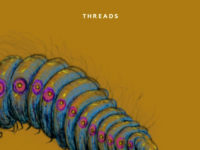Saxophonist and clarinetist John Surman returns to ECM for the first time since 2012 when the acclaimed Saltash Bells was released on the label. On Invisible Threads, he plays with Brazilian pianist Nelson Ayres (Dizzy Gillespie, Benny Carter, Chico Buarque and others) and Oslo-based American vibraphonist Rob Waring (John Eberson, Espen Rud and many more, including the Rob Waring Trio). This is my first listen to John Surman a long time and all I can say is, “wow.”
I have listened to this musician on and off, mostly off I admit, over the years because some of his music was just too far from any place my mind could find, but Invisible Threads is different for me. I knew John Surman had played with and sat in with some of the best improvisers, and that he was never far away from the British jazz and other music scenes. I made a good call reviewing this album. From the first to last track, there is a richness of style, a generosity of spirit and a breath-takingly honest delivery of music which goes straight to the heart. There’s no messing about.
Invisible Threads opens with a beautiful track, “At First Sight,” played with such gentleness and with a gorgeous accompaniment from the piano and vibraphone. This is a gentle and emotive track with a touch of chorale essence and a delicate beauty interspersed by the emotive expressive playing and the perfect placement of notes – and spaces. It is far too short, at a tadpole’s tail over two-and-a-half minutes, but what an opener.
“Autumn Nocturne” opens with a piano introduction – well, it is a nocturne) – before the vibraphone joins, adding a light and more esoteric nature. When the sax enters, it is timorous and the melody is played with a delicacy, as if treading carefully. The three sounds together make a sumptuous and engaging mix, with the piano playing its own progressions and tunes over which the sax soars with its counter-song. The classical leanings of this number are pure and essential to the overall dream-like and thoughtful effect.
“Within The Clouds” opens with a poignant, rich, deep solo with a slightly echoed effect; John Surman travels the registers with ease. The vibraphone joins and now the bass is used for punctuation, offering whimsical and capricious notes uttered under the themes of the vibraphone and piano. The joy of this piece is not only the tender delivery but the variation with which the themes are played with, sorted, taken apart and gently, tenderly built again.
“Byndweed” is curvy, coming in waves and set in motion with piano before the vibraphone echoes the melody and the piano switches to chord accompaniment. Then, all at once, it is leading again, with the subtle changes going on almost in the blink of an eye. The triplets flowing from the sax then add a tripping, light-footed sense to the tune and seem to create a 3/4, 6/8 rhythm over the 4/4, then suddenly it is in 3/4 in reality, with wondrous counter rhythms thrown in for good measure. Very clever and the effect is lovely.
“On Still Waters” is dreamy, esoteric and spacey. with the gentlest, most controlled voice provided by a bass clarinet I have heard in a while. The deep, sonorous tones of the instrument are used to the full as well as the higher register and in this piece, though the piano part is lovely, it is a show stealer. I am sure I heard a not-very-subliminal reference to “Rhapsody in Blue” in there, too. “Another Reflection” is a pensive duet between piano and sax, with the vibraphone adding subtle notes to fill the gaps beautifully. Though short, this track works around the theme really well and the clarity of the sax notes – almost oboe-like, when taken to the highest points – is just stunning.
“The Admiral” is as deep as the previous track was high, with the rich low notes of the bass clarinet sounding the call for the others, who then respond with clear, concise notations of their own. The colorful sound of the marimba adds a difference here to the rolling, yawing sense of the piece. There is a familiarity to it, with snippets which sound like they come from “The Candy Man,” and yet also a difference in the combination of instruments and arrangement variation which makes it essentially a unique and clever track. The lower line speaks out over changing tempos and emphasis. Absolutely beautiful.
“Pianga Pitomba” is led in by the percussive tones of Rob Waring on marimba, before the piano enters with a sweet theme and then the sax adds to the mix, imperceptibly weaving in and leading the rest on a merry meander through changes and tempo adaptations. This is a track which has its essence very much dictated by the rhythmic changes and interplays between the instruments – which are frequent and highly engaging.
Nelson Ayres’s “Summer Song,” the only number not composed by John Surman, is very easy listen right the way through. There are some great jazz references in some of the piano lines and, coupled with the easy interaction, there is a sense of happiness and an uplifting feel to this track. “Concentric Circles” is a playful, interesting number which works and weaves itself around and around patterns and musical shapes – hence the title, I am guessing. Though the sax soars with profound voice over the top, it is the consistent piano lines which hold this piece together and make it work.
“Stoke Dameral” is a light, trippy number where each musician shines, with those rhythmic and temporal changes again and it is followed by the title track, which is a great tail-end to the album. “Invisible Threads” contains a waltzy section over which the sax soars smoothly over the rougher and more spacey, yet perfectly timed piano rhythms, returning many times through the piece. This is a lovely, lilting track with many essences, all added, gently blended and crafted to create the most beautiful piece on the album – perhaps.
Writing about John Surman’s Invisible Threads was so enjoyable because firstly there is so much going on, so much to listen to, it is a sheer delight. The tracks hold a lyrical, narrative quality which creates pictures in the mind. There is also a sense of differences in origin of the musical styles and method of playing. Here, Surman is the typical countryside man, controlled, contrasting wonderfully with the flamboyancy of the piano in places and the colorful percussive style of the marimba and vibraphone.
Yet, for all the content there is no excessive complexity, which means it never loses the listener. There is no rhythm section per se but the method of striking the marimba as if with a hammer in some places, together with the percussive style embraced by the piano, mean the rhythms and patterns are driven outwards from somewhere inside the trio – and it works. What I enjoyed too was how different pieces are written with strong reference to styles like classical, nocturne, jazz, swing – it’s all in there and also references to other genres within the tracks themselves. Invisible Threads is an absolute gem of an album. Of course, the highly polished delivery add to the experience. This is a great album, whether you are familiar or new to John Surman’s music.
- Wabi Sabi – ‘The Love Insane’ (2024) - March 24, 2024
- James McGowan Ensemble – ‘Reaching In’ (2023) - December 10, 2023
- Defne Sahin – ‘Hope’ (2023) - November 19, 2023




